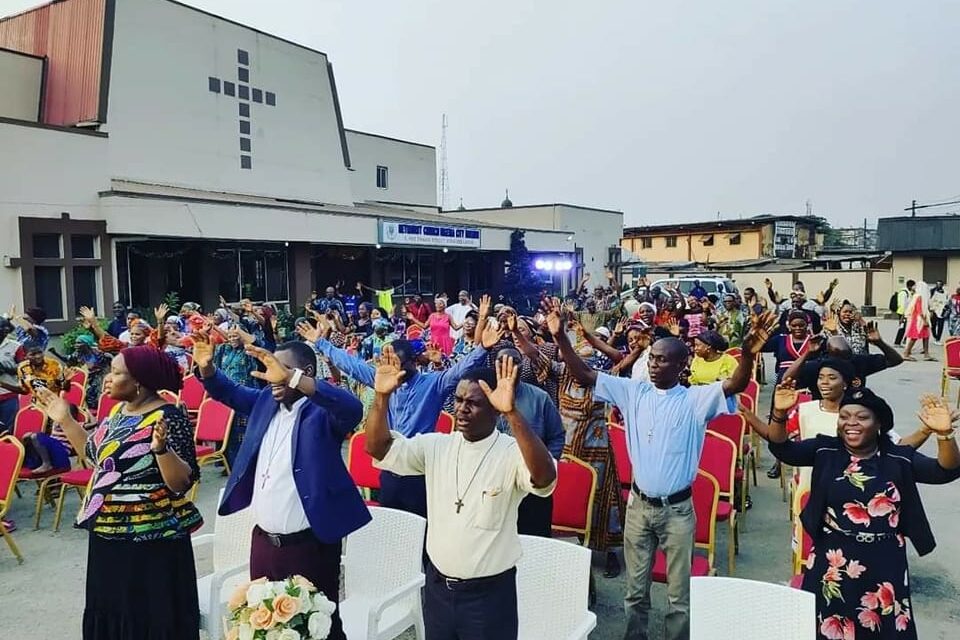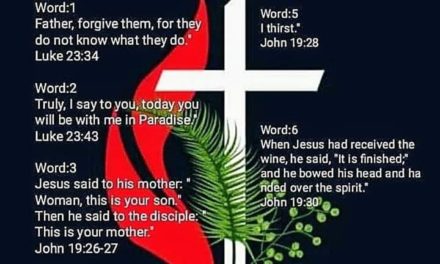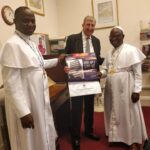Look unto Him, ye nations, own
Your God, ye fallen race
Look and be saved by faith alone,
Be justified by grace – Charles Wesley
The reverse mission is understood within the context of reverse migration equipped and sent to ‘serve the present age.’ These services are with a consecration that put all the practical powers of life and its cherished possessions at Christ’s disposal. Reverse mission as a consecration to a mission, to the world-mission of the Redeemer Himself is shaped by order of things in the economy of grace – saintship and service, inward dedication, and outward activity; ‘the sanctifying of heart and will import the yielding of hands and tongue, talents and good, an entire and living sacrifice.’ The reverse mission shaped by the Wesleyan perspective is about evangelism volunteers called to face the most distant exile, dangerous climate, or savage form of heathen life. With a sense of mission life in the Spirit and a call to joint responsibility to Christ, the reverse mission is about missional mutual oversight, especially preaching that effortlessly flows into evangelism and evangelism into the mission.
It was evangelism that gave birth to Methodism, and it is evangelism that will stop the decline and revive it again. Rev Dr. Martyn Atkins, a former President Methodist Church in Britain, said, “Methodism came into being by some pretty effective evangelists. And Methodists who distance themselves from any notion of evangelism are cutting the ground from under their feet.’ Atkins explained, ‘ one of the big challenges for Methodism at the moment is thinking creatively about the opportunity for evangelism.’ According to him, the problem today is that many good, honest Methodists believe evangelism is not for them. They associate it with manipulation or emotionalism, or door-knocking. They say they want nothing to do with it because it is intrusive, demeaning, or whatever’ (Atkins, M., The Connexion, Issue 1 Winter 2015, pp.6-7). Rev Dr. Stephen Skuce, a former Director of Scholarship, Research, and Innovation in the Connexional Team, aptly explained that Methodists ‘are poor at evangelism … good at mission. We make lots of contacts with those outside the Christian faith.’ Skuce explained that the key problem for us today is that ‘we have not fully recognised the distinction between mission and evangelism, and consequently not developed our missional opportunities into evangelistic encounters.’ The opportunities calls for Methodists to become better evangelists, moving ‘from good mission to excellent evangelism.’ According to Skuce, ‘if evangelism is an area where British Methodism needs to learn from world Methodism, we also need to learn from the World Council of Churches (WCC) (Skuce, S., The Connexion, Issue 1 Winter 2015, p. 10).
The reverse mission as mission opportunity is about the commonwealth of soul in Christ, called into a journey, to make Methodism thrive again. In contrast to the Overseas mission shaped by the colonial divide and rule system, the Overseas reverse mission is Christ-centered evangelism. Overseas reverse mission as post-Christian evangelism beyond Methodist decline warns, for example, against the colonial pride and ‘failure of the North American Methodism in terms of the mission of the church … aggravated by strong self-serving strains that failed to take into account the global context’ of Methodism and, ‘as a consequence discounted the contributions of Methodists from Africa, Asia, Latin America, and elsewhere.’ Using the words of Kenneth Collins, post-Christian evangelism beyond Methodist decline is about ‘the Methodism of the twenty-first century that will be vibrant will recognize that Christ and Christ alone is the head of the church, his body and that Methodists throughout the world are members together, in equal partnership, of that same body in mission.’ Methodism as a world mission (an association of churches in Methodist tradition in 138 countries) has nothing to do with decline if we are faithful and fruitful in soul-winning and scriptural holiness. The reflection is, are we faithful and fruitful? We decline when we compromise basic gospel teachings and are ‘co-opted by strong cultural currents that undermined the raison d’être of Methodism.’ We cannot be fruitful if we are not faithful to the Scriptures as the supreme guide to faith and practice. Overseas reverse mission as post-Christian evangelism beyond decline is shaped by ‘a comprehensive set of practices for Christian initiation and formation.’ Overseas reverse mission as post-Christian evangelism contrasts ‘a shallow connotation of evangelism as merely advertising towards the goal of membership recruitment.’ A humble understanding of our purpose, heritage, and roots as Methodists foretell our future while our denials, unfaithfulness, and disobedience will not stop at our decline but our extinction. Overseas reverse mission as post-Christian evangelism beyond Methodist decline is about expression and proclamation of Methodism as a living faith, not to become a museum as we face an ‘epidemic of closures.’
The massive movement of people has often determined Church and human history. Professor Andrew Walls identified two migratory patterns. The first legacy of the old empires was the Great European migration which saw Europeans at the end of the 15th century to the middle of the 20th century moving into other parts of the world such as Africa, Asia, and Latin America. The movement and home missionary activity during the 19th century were with the ripple effects of the ‘Enlightenment views of an increasingly confident and stridently secular Western culture,’ which also set the pattern for missions abroad, especially in education activity and secular affairs. Alison Twells, in his book, The Civilising Mission, and the English Middle Class, 1792-1850: the ‘Heathen’ at Home and Overseas, shows that ‘the same people were often leaders in Sunday school work and domestic philanthropy, and in missionary work overseas.’ The application of the language of overseas mission field – ‘darkest’ and the heathen’ was not limited to missionary works overseas and the abolition of the slave trade but ‘to areas of Britain’s towns and cities, especially to London, the capital of that Christian empire with which mission was inextricably associated.’
The establishment of the Society for Promoting Christian Knowledge (SPCK) in 1698 and the Society for the Propagation of the Gospel in Foreign Parts (SPG) in 1701 herald a brighter day for the English Church and the formation of the Church Missionary Society (CMS) in 1799. While the SPCK and SPG ‘sustained till 1824, the work of the Danish Halle Mission in South India,’ the SPG sent John Wesley to Georgia in 1735 chiefly for ‘the spiritual welfare of the British Colonies and Dependencies’ and to evangelize the heathen Indians. After Wesley’s world-mission outlook, his encounter with the community of the Moravian Brethren was an example ‘to all Christendom demonstrated, for the first time since the days of early Christianity, how the salvation of mankind should be made a vital interest of the Church and the dominant purpose of its entire membership’ (Findlay and Holdsworth, The History of the Wesleyan Methodist Missionary Society, Vol. 1, 1921)
The Evangelical Revival of the 18th century, which bears on its front name of the Wesleys, was based on John Wesley’s insight into colonial and foreign missionary problems. John Wesley ‘had come face to face with living heathenism on its soil and felt its pitiful appeal. His subsequent thinking and teaching were coloured, and the trend of his work for his own country was influenced by the two years of early manhood (1736-38) spent on the edge of the pagan world.’ The influence of the Moravians’ missionary impulse and character on Wesley and the Methodist revival not only made the whole ethos and drift of the Methodist movement for world evangelism. It shaped the organisation genius of the Methodist Church under the governing body of the Conference and divided its affairs among several departments.
The personal antecedents of the Wesleys gave a significant indication of the world-missionary impulse proceeding from the Revival and seized on the Methodist people with peculiar force; ‘their organisation and modes of fellowship supplied an instrument for its communication.’ Methodism was a worldwide aim from its inception. The Wesleyan Revival was a reaction against ‘narrowing conceptions of the Gospel and the Church of Christ, whether Calvinistic, sacerdotal, nationalist, or particularist of whatever kind.’ Methodist Revival adopted ‘Universal Redemption’ as the watchword of its Preacher. The Methodists’ formal signature and incorporation into the missionary work began in 1813 with the establishment of the ‘Missionary Society’ of Methodism, a form of transition from personal to connexion management. It is important to note that the missionary service of the Wesleyan Church began as early as 1760, about twenty years after the Wesleys commenced their work of evangelising their own country.
The Methodist Home Mission helps churches in thinly populated, rural areas or downtown districts maintain their witness. The Church overseas is the work of the Methodist Missionary Society in Europe, Asia, Africa, the West Indies, and South America. Sadly, today, ‘Methodism shared in a general trend which saw Christians in Europe and North America outnumbered by Christians in the tropics and the southern hemisphere.’ In a reversal of movement, missionaries from overseas began to arrive in Europe, ‘a few of them facilitated by the MMS’s World Church in Britain and Ireland Partnership.’
Walls’ second migratory pattern is the Great Reverse Migration which has brought people from the Majority world to the West (Walls, Crossing Cultural Frontiers, 2017, 49-51). Through this second migratory shift, Christian missionaries from the Caribbean, Asia, Latin America, and Africa have come to the West to do their mission. It is important to note that the Caribbean migration of the Windrush generation saw the planting of Holiness and Pentecostal churches in the 1940s. Methodism remains one of the mission movements of the Great European Migration when ‘Christianity was overwhelmingly a Western religion and indubitably the religion of the West, so much so that for centuries the term “Christendom” – which is simply another word for Christianity – was equated with Europe. Europe was Christianity, Christianity territorially expressed.’
As part of the effects of the Great European Migration, Overseas Missions Sunday reminds us of one of the activities behind the growth and spread of Methodism as a world church. Every Methodist is proud of and thankful to God for the beautiful story of our Overseas Missions and the Methodist Missionary Society (MMS). Indeed, what began with stirring adventure and great enterprise in the days of John Wesley, who sent his preachers to America in the days when Indians still held the land except for a few strips along the coast and the rivers, provides us today a template for Overseas Reverse Missions (ORM). In that New World, Methodist missionaries won a commanding place and played a massive part in shaping the civilization that has now come to the world’s leadership.
It is on record that Methodist missionaries found their way into almost every corner of the earth. They have built Methodist churches in cities and remote villages on the fringes of deserts, jungles, and islands of the seven seas. Methodist missionaries founded schools and erected and staffed large hospitals, thus carrying education and health, as well as the Gospel, to millions of people. Methodism became a world church. Everywhere it has penetrated, it has carried with it its family “connexions” so that a Methodist is not only “at home” in any town or village in almost any land under the sun.
The fruitfulness of MMS Overseas work remains an influential factor and template for the Overseas Reverse Mission, post-Christian evangelism in the binding together of Methodists, a great family of nations. At a time when Methodist Church in Britain is declining, and particularly the Christian Church in the West faces the first post-Christian, deeply secular culture in history, overseas reverse missions remain not just a renewing post-Christian evangelism, it suggests a new mutual partnership, a ‘way to do evangelism with the secular and the “nones” that gains traction and sees many people regularly coming to faith.’ Overseas reverse missions as post-Christian evangelism are about more than just African mission work in the United Kingdom or anywhere. Overseas Reverse Mission using the words of Rev Pete Pillinger, points to ‘diaspora communities from various of our former colonies. From my point of view, the bread we cast upon the waters had returned to bear fruit.’ Methodism has taken root and flourished beyond where it was raised.
To bear renewing and abiding fruits, we need mutual respect and humility. Overseas reverse mission as post-Christian evangelism as a living out the obedience of faith and the glad tidings of salvation ‘entails a mobilization of lay people in evangelism, as in the early Church. The Overseas reverse mission as post-Christian evangelism is to express and ‘demonstrate to deeply skeptical people that Christianity’ is redeeming, renewing, respectable, desirable, and believable. Overseas reverse mission through post-Christian evangelism beyond Methodist decline demonstrates that Christianity is respectable and redeeming from every work and power of darkness. The Overseas reverse mission can potentially empower the home Missions to work in great city missions, caravan missions in rural areas, prisons, and hospitals among international students and the Navy, Army, and Royal Air Forces.
Overseas reverse mission as post-Christian evangelism beyond Methodist decline is about renewing the story of the Spirit in which the Wesleyan Church went forth under the influence of the Evangelical Revival to fulfil her Master’s commission and to ‘make disciples of all the nations.’ The Overseas reverse mission is about the renewal of the religious life of the Church universally in order to quicken the life of the Church in more materialistic generations. Overseas reverse mission as post-Christian evangelism beyond church decline is to make the Church again ‘glorify God in’ these later Apostles to the Gentiles,’ the Wesleys. Overseas reverse mission as post-Christian evangelism beyond church decline is about spiritual devotion and partnership between the Church at home and the diaspora, sharing in full measure the missionary spirit as ‘the Wesleyan communion of the Christian church was wholly missionary from its inception.’ Overseas reverse mission as post-Christian evangelism beyond church declines counters the Enlightenment narrowing conceptions of the Gospel and the Church of Christ. Overseas reverse mission as post-Christian evangelism beyond church decline is about looking at the world as a mission parish confessing ourselves like Paul, ‘a debtor to every man,’ ‘teachers of the nations in faith and truth.’ Overseas reverse mission as post-Christian evangelism is a renewing advance of Methodism evangelical faith through the pursuit of holiness engrossed in the minds of Preachers and people shaped by the internal work of the Holy Spirit as in the early Methodist missionary mind. Beyond the revisionist Methodism shaped by ‘a compromising and co-opting culture’ and self-indulgent love, Overseas reverse mission as post-Christian evangelism beyond Methodist decline calls us to holy love that shaped the vision, ministry, and purpose of early Methodism.











Recent Comments